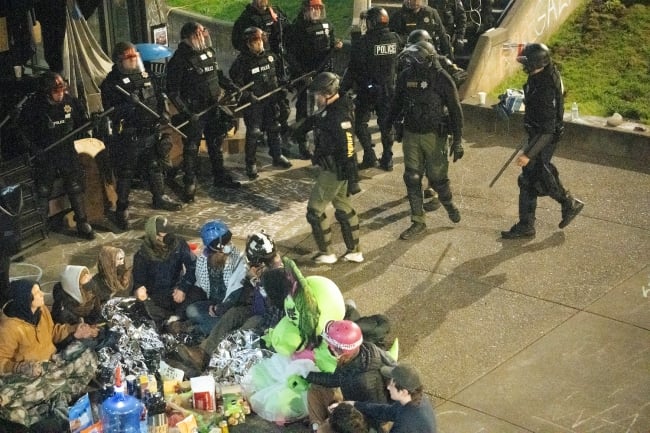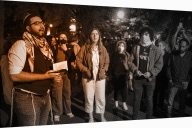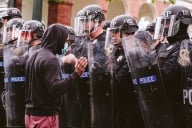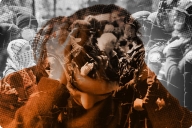You have /5 articles left.
Sign up for a free account or log in.

Police arrived at Cal Poly Humboldt at about 2:30 a.m. on Tuesday; protesters say they knew that officers were coming thanks to reporting by the campus radio station.
Savana Robinson
Under cover of darkness early Tuesday morning, about 100 law enforcement officers swarmed the campus of California State Polytechnic University, Humboldt, to secure two buildings occupied by student protesters.
Participants had been in one of the buildings, Siemens Hall, a central administrative and academic building, for more than a week. During that time, they broke into the president’s office and wrote phrases including “BLOOD ON YOUR HANDS” and “Viva viva Palestina!” on the walls in spray paint and what looked like permanent marker.
The Unified Command, a group of police officers from across the state that carried out the operation at about 2:30 a.m. Tuesday, arrested 31 individuals outside Siemens Hall on charges of unlawful assembly, vandalism, conspiracy, assault of police officers and more. Video from the scene taken by the Lost Coast Outpost, a local news outlet, showed people sitting outside in a circle, arms linked, around what appears to be a pile of supplies, waiting to be arrested. According to Occupy Cal Poly Humboldt, an Instagram account that appears to be run by protesters, they knew the police were coming, thanks to reporting from the institution’s radio station.
In a press release the following morning, Tom Jackson Jr., president of the California State system’s smallest institution, described the occupation as “serious criminal activity that crossed the line well beyond the level of a protest.”
“I commend the law enforcement team for their effort in resolving this very dangerous situation, and I’m incredibly grateful for the many agencies who advised us and who came to our aid in our time of need,” he said, also praising the staff at the rural northern California campus of just under 6,000 students. “Our focus for the entire time has been on doing all we could do to protect the safety of all involved, and we were very patient and very disciplined with that.”
The arrests followed a trend of university leaders coordinating with law enforcement to shut down pro-Palestinian encampments—although unlike at Cal Poly Humboldt, most other demonstrations occurred outdoors on campus lawns and quads. Right-wing politicians have widely applauded such efforts to restore law and order to campuses that they say have been overtaken by student demonstrators. But many free speech scholars have condemned efforts to quash students’ free expression.
Chessie Thacher, a senior staff attorney for the Democracy and Civic Engagement program at the American Civil Liberties Union of Northern California, noted that occupying a building is different from speaking out on a public quad.
“When you’re entering a building, it does complicate things because you’re no longer in this public forum,” she said. “Most scholars would say that you don’t have a First Amendment right to enter a building and stage a protest. But just because you don’t have a right doesn’t mean peaceful occupation should be met with excessive force.”
In addition to the arrests, at least some of the students who were arrested have been suspended, according to a post on the Occupy Cal Poly Humboldt Instagram, and at least one of the individuals who was arrested was a professor.
A Week of Turmoil
The arrests marked the culmination of more than a week of rising tensions between administrators and the protesters in Siemens Hall, which they renamed “Intifada Hall.” Students first entered the building on April 22, barricading themselves inside using furniture, according to a university press release. Local news organizations reported that police faced off with protesters that same day, resulting in three arrests. During the confrontation, a protester hit a police officer on the head with an empty water jug; a video of the moment went viral among pro-Palestinian student protesters worldwide.
In an interview with It’s Going Down, a website dedicated to documenting anarchist, anti-capitalist, anti-colonial and anti-fascist movements, one of the occupiers, identified only as Sequoia, said that numerous protesters were injured by officers in that confrontation, which lasted six hours. They also said that a large crowd had gathered outside of Siemens Hall to support the occupiers.
Like many of the students who have erected pro-Palestinian encampments across the country, the Cal Poly Humboldt protesters have called on the university to disclose its ties to Israel and to boycott the Jewish state and its academic institutions, as well as to divest its endowment from weapons manufacturers and companies with ties to Israel.
The university said in a statement that it has no partnerships with Israeli institutions and no direct investment in weapons manufacturers or Israeli companies, and that its indirect investments in such companies makes up less than 0.5 percent of its portfolio.
On the evening of April 22nd, administrators closed campus, locked buildings and ordered professors to teach virtually. The shutdown was initially intended to last just one day, but officials quickly extended it through the weekend. Eventually, university leaders turned the closure into what they called a “hard campus closure” through the end of the semester on May 10. At the time, that made it one of the nation’s most far-reaching responses to pro-Palestinian protests—though since Cal Poly Humboldt closed, universities including Columbia and Tulane have also announced that classes would go online due to occupations or encampments.
Cal Poly Humboldt’s closure still holds, even though Siemens Hall and Nelson Hall East have been cleared out; individuals are barred from entering campus without permission. Residential students can remain, but they are only allowed in the dorms and the dining facilities. The two main roads leading into campus are closed.
Administrators said in a statement that they had tried to negotiate with protesters to get them to demonstrate in a nearby quad, offering them the opportunity to leave the buildings without risk of arrest. But the protesters did not take the offer.
Stephanie Burkhalter, a professor of politics and a senator on Cal Poly Humboldt’s University Senate, said protesters briefly left the building Friday but ended up going back inside shortly after. She wasn’t sure why they changed their minds, but speculated it might have had something to do with an article in the Eureka Times-Standard that afternoon that quoted President Jackson saying the protesters were “not staying in there for noble causes,” but were “criminals.”
A statement released by the university on Sunday, before the police arrived, echoed the president’s comments, saying that administrators took issue not with “the protest itself” but rather with the “ongoing unlawful occupation of campus buildings by students and non-students and other criminal acts.” It cited theft, vandalism, intimidation of university staff and more, raising concerns about the safety hazards protesters had created by barricading the entrances to Siemens Hall.
“It is lawless behavior that has harmed the vast majority of our students whose education has been interrupted, damaged the reputation of our school, and drained resources from the accomplishment of our core educational purpose,” officials wrote, alleging that protesters had done millions of dollars’ worth of damage.
(In the It’s Going Down interview, Sequoia said student protesters only erected barriers to protect themselves after police arrived on campus.)
Burkhalter has not set foot on campus since courses went online, but said she has daily communication with faculty members who have been camping out with the students to help keep them safe and to serve as liaisons between demonstrators and administrators. Her faculty colleagues never saw the protests as violent, though she said that demonstrators had attempted to break into other campus buildings and faculty offices. Nonstudents had also joined the protest, Burkhalter said, although Sequoia said in the podcast that the nonaffiliated protesters were all alumni or personal friends of the occupiers.
Overall, Burkhalter said that the university’s framing of the protest as dangerous and criminal doesn’t align with faculty observations. She said the language officials have used in press releases and campus alerts has done more harm than good.
“Those statements are escalating the issue,” she said. “This is traditionally a campus that has had left-wing and environmental protests before, so we understand what this is … it’s still, at its core, a quintessential student protest.”
‘Never Seen Anything Like This’
Chris Harmon, a chemistry professor who has been at Cal Poly Humboldt for 13 years, said he had advised students to leave campus even before the institution implemented the hard closure; after all, classes were virtual anyway, and his department had decided to excuse students from clearing out their lab benches at the end of the term.
But Harmon is worried about the students who remain on campus, unsure if they are permitted to access resources they might need, such as the campus health center, which is near Siemens Hall. It’s the first time the university has ever opted to shut down the campus over a protest, he said.
“I’ve been around long enough to see other student protests; this is definitely unique,” he said. “I’ve never seen anything like this.”
Burkhalter said that she has heard from faculty that some students are so scared to come out of their dorms that they’ve gone hungry rather than venture to the dining hall.
Students “are incredibly frightened” by the emergency alerts being sent to the campus community, she said. “They’re afraid to go out of their rooms."
The alert sent Tuesday morning shortly after police arrived on campus read: “Due to continuing criminal activity on campus, residents living on campus should shelter in place. Anyone who is off campus should stay away. There is an increased level of criminal activity on campus. It is dangerous to be out on campus at this time. In order to protect life and safety, residents on campus should shelter in place in their residence halls and remain alert to their surroundings.”
Samuel Parker, a junior who is president of Cal Poly Humboldt’s student government organization, Associated Students, said that the hard campus closure came as a shock to the student body, himself included. Multiple members of the Associated Students had left items in the group’s on-campus office, which they have been unable to access since Friday; other students have been unable to retrieve items they left elsewhere, such as in lockers in the library.
Associated Students has not had contact with the administration since the first days of the occupation, when members had a brief conversation with Chrissy Holliday, vice president for Enrollment Management and Student Success, Parker said; a meeting he had scheduled with the dean of students was indefinitely postponed when classes went virtual. He also said he is supposed to have regular meetings with President Jackson, but they haven’t spoken since the fall.
“I would like to hear [the administration’s] perspectives on it more and see if they realize how the way they treated it was kind of blown out of proportion,” he said.
Faculty, too, have expressed dissatisfaction with the administration’s handling of the protest—particularly Jackson and the institution’s chief of staff, Mark Johnson, neither of whom have spoken with faculty directly since the occupation started last week, according to Harmon. In an emergency meeting on Thursday, 193 of 203 faculty attendees voted no confidence in the two administrators; seven voted against and three abstained. On Monday, 320 faculty members signed a letter asking them to resign.
The letter criticized them for calling the police on student protesters when they first occupied Siemens Hall before making any attempt to talk with them. It also decried the hard campus closure for escalating the situation and called out the lack of communication from top administrators.
“Jackson’s and Johnson’s permission for excessive use of police force, coupled with a complete absence of consultation with us, and Jackson’s repeated avoidance of communication and visible leadership since his hire, demonstrate a disregard for the safety of our students, disrespect for faculty and staff, and an alarming lack of understanding of our campus culture,” the letter said.
Cal Poly Humboldt did not respond to a request for comment on the letter and the no-confidence vote.








